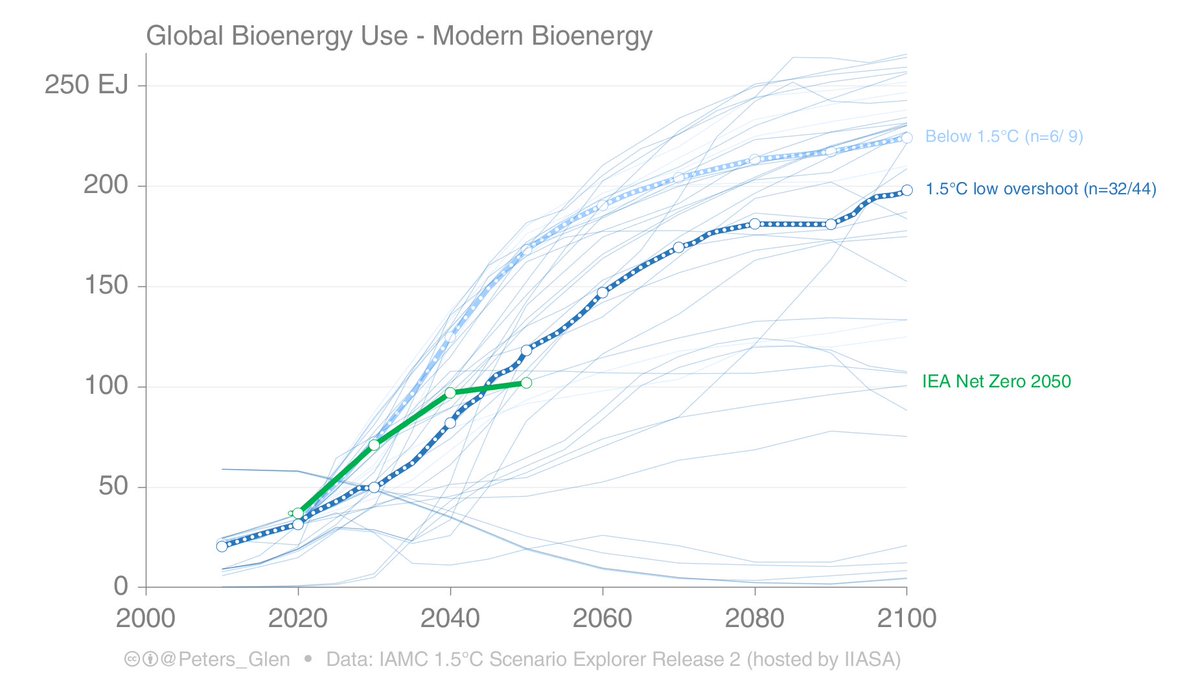THREAD: Bioenergy use in the @IEA Net Zero 2050 scenario
I have seen a few comments that the IEA uses loads of bioenergy. Let's have a look...
First up, overall, bioenergy use is lower than in equivalent scenarios assessed by the IPCC, particularly in 2050.
1/
I have seen a few comments that the IEA uses loads of bioenergy. Let's have a look...
First up, overall, bioenergy use is lower than in equivalent scenarios assessed by the IPCC, particularly in 2050.
1/

2. An important detail is that the IEA assumes traditional biomass is gone by 2030. Traditional bioenergy "is unsustainable, inefficient & polluting, & was linked to 2.5 million premature deaths in 2020"
The IPCC only has a slow drop, so the IEA must build up modern bioenergy.
The IPCC only has a slow drop, so the IEA must build up modern bioenergy.

3. In terms of modern bioenergy, the IEA has similar levels as the IPCC up until 2050.
* Rapid growth to 2030 is to compensate traditional bioenergy
* Slowdown to 2050 is to limit to 100EJ per year, view by many as sustainable.
* Rapid growth to 2030 is to compensate traditional bioenergy
* Slowdown to 2050 is to limit to 100EJ per year, view by many as sustainable.

4. Where is the bioenergy used?
* Big drop in traditional use
* Electricity: Provides balancing for wind/solar & can be used with CCS (BECCS) for CO₂ removal
* Heat: 50% district heating
* Industry: pulp/paper, steel, ...
* Transport shift from road to air (50% in 2050)
* Big drop in traditional use
* Electricity: Provides balancing for wind/solar & can be used with CCS (BECCS) for CO₂ removal
* Heat: 50% district heating
* Industry: pulp/paper, steel, ...
* Transport shift from road to air (50% in 2050)

5. Where does the bioenergy come from?
A large part of the growth is organic waste & forest residues.
25EJ is from short-rotation woody crops & 10EJ from forestry plantings. These last two require land.
A large part of the growth is organic waste & forest residues.
25EJ is from short-rotation woody crops & 10EJ from forestry plantings. These last two require land.

6. The land puzzle is hard to figure out. Some land is for bioenergy crops and some is for forests.
"The total land area dedicated to bioenergy production in the NZE increases from 330 Mha in 2020 to 410 Mha in 2050"
"The total land area dedicated to bioenergy production in the NZE increases from 330 Mha in 2020 to 410 Mha in 2050"
7. For bioenergy crops:
"There is 130 Mha of land used for short‐rotation advanced bioenergy crops in 2050 & 10 Mha for conventional bioenergy crops" (140Mha in 2050, no information on pathway to 2050).
Land use is less than most IPCC scenarios in 2050.
"There is 130 Mha of land used for short‐rotation advanced bioenergy crops in 2050 & 10 Mha for conventional bioenergy crops" (140Mha in 2050, no information on pathway to 2050).
Land use is less than most IPCC scenarios in 2050.

8. "There is no overall increase in cropland use for bioenergy production in the NZE from today’s level & no bioenergy crops are developed on forested land in the NZE"
9. Forest bioenergy:
"In 2050, ~270 Mha is forest, representing
around one‐quarter of the total area of global managed forests & around 5% of total forest
area"
I guess this is forestry plantations for bioenergy? Not possible to compare this to IPCC.
"In 2050, ~270 Mha is forest, representing
around one‐quarter of the total area of global managed forests & around 5% of total forest
area"
I guess this is forestry plantations for bioenergy? Not possible to compare this to IPCC.
10. "Total land use for bioenergy in the NZE is well below estimated ranges of potential land availability that take full account of sustainability constraints, including the need to protect biodiversity hotspots"
11. The discussion of bio is reasonably detailed, spread in different parts of the report. I would not say the scenario is extreme on bioenergy, but generally less bioenergy than in the IPCC.
Read more: iea.org/reports/net-ze…
/end
Read more: iea.org/reports/net-ze…
/end
• • •
Missing some Tweet in this thread? You can try to
force a refresh
























